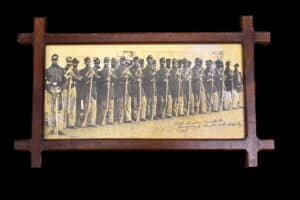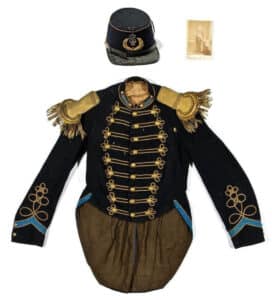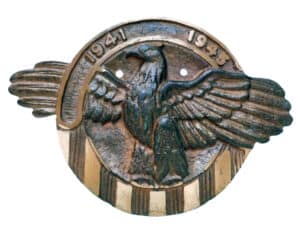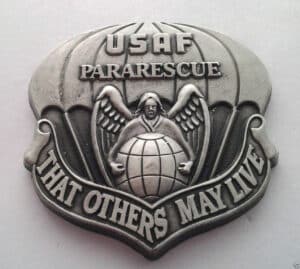by Judy Gonyeau, managing editor
Remembering and honoring the many who have served our country fills numerous museums, is written on monuments, and is in the hearts of all who have served and their families. Militaria is the field of collecting that helps everyone learn about and keep a promise to members of our military. Collectors range from those who have family who served to others who are life-long learners about the tools, uniforms, medals, images, grave markers, correspondence, and more that have made their mark on history.
Through these tokens, everyone can appreciate and honor the duties and sacrifices of those who have served and help to preserve their history.
The United States Army

As the founding branch of the U.S. Military, the Army is the land service branch of the U.S. Armed Forces. Founding members were in what was then called the Continental Army, formed on June 14, 1775, just before the U.S. formed as a country. It was not until after the Revolutionary War that Congress created the U.S. Army on June 3, 1784. Because it is believed that it was truly a continuation of the Continental Army, the Army considers its starting date to be 1775. Today, the U.S. Army remains the largest military branch.
Photography
In her book The Black Soldiers of the Civil War, Deborah Willis shares over 70 photos, letters, journal entries, and posters of those who served in the Union Army at that time. In the introduction, Willis explains, “Photographs were a luxury; their prevalence shows their importance as records of family, position, identity, and humanity, as status symbols.” Highly collectible, photos of black soldiers from this era can be found for under $100 but increase in value with provenance.
The United States Navy

The origins of the maritime service branch of the U.S. Armed Forces, like the Army, stretches back to the American Revolutionary War as the Continental Navy but was disbanded after suffering a significant loss of goods and personnel thanks to the actions of the Barbary pirates from Algiers. The U.S. Congress then passed the Naval Act of 1794 and commanded the building of six heavy frigates to form the first of many fleets that would continue to grow so that today, the Navy has more battle fleet tonnage than any other navy in the world.
Uniforms
From the start, U.S. Naval uniforms set out to be distinctive in style and in useability. While nothing beats the crisp white uniforms shown in Hollywood movies, it was not until after the Civil War and during the World Wars that uniforms were standardized. The distinction between dress and service uniforms were solidified for working on the job and socializing. Diverse clothing structures were customized according to position, especially as the Navy expanded into the air and were active overseas climates. The classic peacoat, invented by the Dutch Navy in the 1800s, is a look and style that has stood the test of time in the Military and on the streets of the Fashion District in New York.
The United States Air Force

From the very first flight dating back to 1903 and the Wright brothers, the sky quickly became a territory to be explored and protected. On August 1, 1907, the U.S. Army Signal Corps established a small Aeronautical Division to take “charge of all matters pertaining to military ballooning, air machines, and all kindred subjects.” As the development of planes and their capabilities grew to be more technically advanced, the focus on military aviation grew by leaps and bounds through the first and second world wars. The United States Air Force became a separate military service in September 1947 with the implementation of the National Security Act of 1947.
Special Tactics: the Pararescue
Pararescue became necessary during World War II, and has since been a constant part of U.S. military heritage and the Air Force mission.
The history of pararescue began in August of 1943, when 21 U.S. military members bailed out of a disabled C-46 over an uncharted jungle near the China-Burma border. From that point on, the Air Force pararescuemen (also known as “PJs”) have brought this specialty to the forefront when rescuing anyone who has landed in a disaster situation.
The United States Marine Corps

The Marine Corps is the maritime land force service branch of the Armed Forces focused on expeditionary and amphibious operations by using specially trained personnel manning its own infantry, armor, artillery, aerial, and special operations forces. In 1775, two battalions of Continental Marines were formed in Philadelphia, and while working closely with their sister branch (the U.S. Navy), the Marines gained a reputation as expert marksmen. The Marines were often threatened with dismantlement until the 1952 Douglas–Mansfield Act gave Marine Corps Command an equal voice with the Joint Chiefs of Staff.
The Marine Corps Band
In the nation’s capital of Philadelphia, President John Adams signed an Act of Congress establishing the United States Marine Band on July 11, 1798. The original “32 drummers and fifers” assisted in recruiting Marines and entertained residents. The Band became a renowned symbol for the Marine Corp as it accompanied President Lincoln to Gettysburg, performed on the White House South Lawn for President Roosevelt and Winston Churchill in the rain played under the leadership of John Phillip Sousa and has toured the world as an ambassador organization for the U.S.
Marking the Graves

Military flag holders serve as a quick identifier of those who served during a particular wartime when walking through a hometown cemetery, but they go beyond simply stating “a veteran lies here” to sharing more information about where they lived, the wartime during which they served—whether on the battlefield or not—or died.
The American Legion was commissioned in 1919 as a Veterans Organization to promote volunteerism and helpfulness. This is the organization that most often contributes to honoring the military members with a military flag holder.
Each state determines the materials used to create these markers, but older flag holders were made of iron. To learn more about these markers and the wars identified by them, you can go to the American Legion website (www.legion.org) or visit www.blog.billiongraves.com for a good introduction to the history of the markers and many images of the variety of flag holders that exist across the country.
At left, a brass World War II cemetery marker features the Honorable Discharge symbol commonly known as “The Ruptured Duck.” It is patterned after the patch that was sewn onto service member’s uniforms to identify those who had been honorably discharged. The bird was intended to be the bald eagle, but some Veterans thought it looked more like a duck. It was facing to the right, the same direction doctors told patients to face when asked to cough during an examination for ruptures. All inside-jokes aside, these World War II gravestone markers are meant to honor those who sacrificed to provide protection for their nation and promote freedom.





Related posts: